
Peterborough is a cathedral city in the City of Peterborough district in Cambridgeshire, England, with a population of 215,700 in 2021. Originally part of Northamptonshire, it became part of Cambridgeshire from 1974. The city is 76 mi (122 km) north of London, on the River Nene which flows into the North Sea 30 mi (48 km) to the north-east. The railway station is an important stop on the East Coast Main Line between London and Edinburgh.

The City of Peterborough is a unitary authority district with city status in the ceremonial county of Cambridgeshire, England. The area is named after its largest settlement, Peterborough but also covers a wider area of outlying villages and hamlets. Historically the area was split into parts between the counties of Northamptonshire, Isle of Ely and Huntingdonshire until 1974 when it became part of the short-lived county of Huntingdon and Peterborough before becoming part of the ceremonial county of Cambridgeshire. Located in the East Anglia region of England, the area borders the surrounding counties of Lincolnshire and Northamptonshire. The population of the district was 202,259 making it the second-largest district by population in East Anglia.
Fletton is an area of the city of Peterborough, Cambridgeshire, England, south of the River Nene.
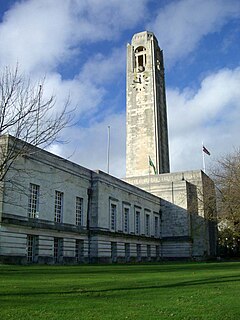
The Guildhall is one of the main office buildings of the City and County of Swansea Council. The Guildhall complex, which includes the City Hall, Brangwyn Hall and the County Law Courts for Swansea, is a Grade I listed building.

Peterborough City Council is the local authority for Peterborough in the East of England. It is a unitary authority, having the powers of a non-metropolitan county and district council combined. The City was incorporated as a municipal borough in 1874; from 1888, it fell within the jurisdiction of the Soke of Peterborough county council and from 1965, Huntingdon and Peterborough county council. In 1974, it was replaced by a wholly new non-metropolitan district, broadly corresponding to the Soke, in the new enlarged Cambridgeshire. In 1998, Peterborough became independent of Cambridgeshire as a unitary authority, but the city continues to form part of that county for ceremonial purposes as defined by the Lieutenancies Act 1997.
Nene Park Academy is a secondary academy school in Peterborough. The school was renamed in September 2011 when it converted to an academy upon joining Cambridge Meridian Academies Trust (CMAT). A new £15 million academy building was opened by Professor Robert Winston in February 2014. The academy's sponsorship by CMAT means it is partnered with the highly rated Swavesey Village College. Nene Park Academy is also home to Peterborough United Football Club's Youth Training Academy, and a partnership has been developed with the club.
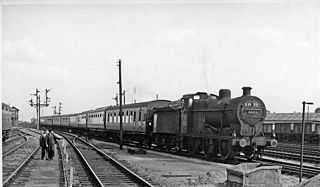
Peterborough East was a railway station in Peterborough, England. It was opened on 2 June 1845 and closed to passenger traffic on 6 June 1966. Located on Station Road just off Town Bridge, only the engine sheds and one platform remain. The station had services running west to Northampton and Rugby, as well as to the east to March, Wisbech, and Norwich.

Cambridge Guildhall is a civic building in the centre of the historic city of Cambridge, England. It includes two halls, The Large Hall and The Small Hall, and is used for many disparate events such as comedy acts, conferences, craft fairs, live music, talks, and weddings. It is also used by the University of Cambridge for certain examinations. It is owned and managed by the Cambridge City Council, and it is their seat of government. The Guildhall is located on the south side of Market Hill, the market square in Cambridge, between Peas Hill to the west and Guildhall Street to the east. It is a Grade II listed building.

Gloucester Shire Hall is a municipal building in Westgate Street, Gloucester. The shire hall, which is the main office and the meeting place of Gloucestershire County Council, is a grade II listed building.

Ernest Berry Webber, was an English architect, surveyor and town planner best known for his designs of municipal buildings, including those in Southampton in Hampshire, and Dagenham and Hammersmith, both in London.

Glossop Town Hall, Market Hall, and Municipal Buildings is a complex in the centre of Glossop, Derbyshire, providing offices for High Peak Borough Council, a retail arcade, and covered market. The Town Hall was constructed in 1838 and significantly extended and altered in 1845, 1897 and 1923. The Town Hall building was designed by Weightman and Hadfield of Sheffield for the 12th Duke of Norfolk. It is constructed from millstone grit ashlar and topped with a distinctive circular cupola and clock. It is Grade II listed, forming a group with the market and Municipal Buildings to the south, and rows of shops to High Street West either side which were also part of Hadfield's design, and which marked the transition of Howard Town from a satellite industrial village to a freestanding urban entity.
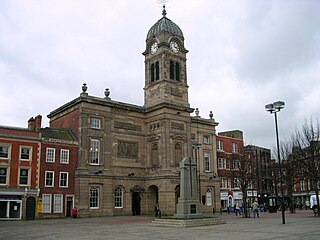
Derby Guildhall is a municipal building in the Market Place, Derby, England. It is a Grade II listed building.

The Old Town Hall is a municipal building in West Street, Gateshead, England.

Grantham Guildhall is a municipal building on St Peter's Hill, Grantham, Lincolnshire, England. It is a Grade II listed building.
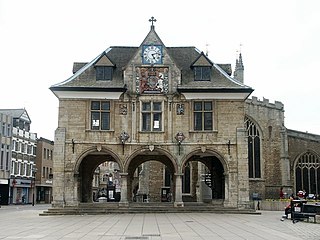
Peterborough Guildhall is a municipal building in Cathedral Square, Peterborough, Cambridgeshire, England. It is a Grade II* listed building.

Launceston Guildhall and Town Hall is a municipal building in Western Road in Launceston, Cornwall, England. The building, which was the meeting place of Launceston Town Council, is a Grade II listed building.
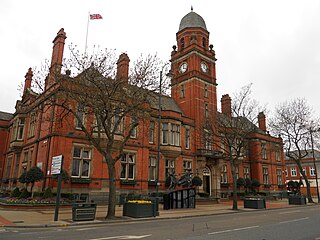
Hyde Town Hall is a municipal building in the Market Street, Hyde, Greater Manchester, England. The town hall, which was the headquarters of Hyde Borough Council, is a grade II listed building.

Dukinfield Town Hall is a municipal building in King Street, Dukinfield, Greater Manchester, England. The town hall, which was the headquarters of Dukinfield Borough Council, is a grade II listed building.

Newport Guildhall is a municipal structure in the High Street in Newport, Isle of Wight, England. The guildhall, which was the headquarters of Newport Borough Council, is a Grade II* listed building.

The Underbank is an area of Stockport, Greater Manchester, containing the streets of Little Underbank and Great Underbank. Originally considered the finest shopping street in Stockport during the 19th century, the street was dubbed as Stockport's answer to Soho following an influx of independent businesses.



















